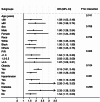Linking metabolic score for visceral fat to heart failure: insights from national health and nutrition examination survey 2003-2018
- PMID: 40640908
- PMCID: PMC12247282
- DOI: 10.1186/s12944-025-02654-y
Linking metabolic score for visceral fat to heart failure: insights from national health and nutrition examination survey 2003-2018
Abstract
Background: Visceral fat has become increasingly recognized as a key modifiable risk factor in the development of heart failure (HF). This study aims to investigate the link between the Metabolic Score for Visceral Fat (METS-VF) and the prevalence of HF, and evaluate whether METS-VF could improve the detection of HF in the general population.
Methods: 24,681 subjects from the 2003-2018 National Health and Nutrition Examination Survey were included in the analysis. HF was determined according to self-reported medical history.
Results: The overall prevalence of HF was found to be 2.91%. After adjusting for relevant confounders, each one-standard-deviation increase in METS-VF was associated with a 75.4% higher risk of prevalent HF. Participants with METS-VF values in the highest quartile had a 2.731-fold greater risk of prevalent HF than those in the lowest quartile. The relationship between METS-VF and HF appeared nearly linear based on smooth-curve modeling, and subgroup analyses confirmed this association across different demographic groups. When METS-VF was added to standard cardiovascular risk factors, there was a slight improvement in HF discrimination (AUC: 0.867 vs. 0.873, P = 0.003). Reclassification metrics also highlighted the incremental value of including METS-VF.
Conclusion: The findings of this study demonstrated a strong, linear relationship between METS-VF and the prevalence of HF, suggesting that METS-VF could be an adjunctive tool for improving HF screening in the general population.
Keywords: General population; Heart failure; Insulin resistance; Metabolic score for visceral fat; NHANES; Visceral adiposity.
© 2025. The Author(s).
Conflict of interest statement
Declarations. Ethics approval and consent to participate: Every subject in the NHANES study provided a written consent for participating in the survey. The NCHS institutional Ethics Review Board approved the study design of NHANES. Therefore, an additional Ethics Review is unnecessary for the current analysis. Consent for publication: Before participating in the study, all participants signed the informed consent. Competing interests: The authors declare no competing interests. Clinical trial number: Not applicable. Declaration of generative AI in scientific writing: Generative AI and AI-assisted technologies were only used in the writing process to improve the readability and language of the manuscript.
Figures



Similar articles
-
Nonlinear association between visceral fat metabolism score and heart failure: insights from LightGBM modeling and SHAP-Driven feature interpretation in NHANES.BMC Med Inform Decis Mak. 2025 Jul 1;25(1):223. doi: 10.1186/s12911-025-03076-7. BMC Med Inform Decis Mak. 2025. PMID: 40597284 Free PMC article.
-
Association between metabolic score for visceral fat and psoriasis: findings from NHANES.Eur J Med Res. 2025 Aug 12;30(1):739. doi: 10.1186/s40001-025-03002-7. Eur J Med Res. 2025. PMID: 40796893 Free PMC article.
-
METS-VF as a novel predictor of gallstones in U.S. adults: a cross-sectional analysis (NHANES 2017-2020).BMC Gastroenterol. 2025 Jul 31;25(1):547. doi: 10.1186/s12876-025-04161-x. BMC Gastroenterol. 2025. PMID: 40745581 Free PMC article.
-
Nutritional interventions for survivors of childhood cancer.Cochrane Database Syst Rev. 2016 Aug 22;2016(8):CD009678. doi: 10.1002/14651858.CD009678.pub2. Cochrane Database Syst Rev. 2016. PMID: 27545902 Free PMC article.
-
[Volume and health outcomes: evidence from systematic reviews and from evaluation of Italian hospital data].Epidemiol Prev. 2013 Mar-Jun;37(2-3 Suppl 2):1-100. Epidemiol Prev. 2013. PMID: 23851286 Italian.
References
-
- Roger VL. Epidemiology of heart failure: A contemporary perspective. Circ Res. 2021;128:1421–34. - PubMed
-
- Savarese G, Becher PM, Lund LH, Seferovic P, Rosano GMC, Coats AJS. Global burden of heart failure: a comprehensive and updated review of epidemiology. Cardiovasc Res. 2023;118:3272–87. - PubMed
-
- Khan MS, Shahid I, Bennis A, Rakisheva A, Metra M, Butler J. Global epidemiology of heart failure. Nat Rev Cardiol. 2024;21:717–34. - PubMed
-
- Kazi DS, Elkind MSV, Deutsch A, Dowd WN, Heidenreich P, Khavjou O, Mark D, Mussolino ME, Ovbiagele B, Patel SS, et al. Forecasting the economic burden of cardiovascular disease and stroke in the united States through 2050: A presidential advisory from the American heart association. Circulation. 2024;150:e89–101. - PubMed
MeSH terms
Grants and funding
LinkOut - more resources
Full Text Sources
Medical
Research Materials
Miscellaneous

